
Croatia have performed well in Russia this year, undoubtedly being the dark horses of the World Cup. Having finished first in their group, Croatia have had a string of impressive performances against the like of Iceland, 2014 World Cup finalists Argentina, and most recently Nigeria, the 2013 Africa Cup of Nations winners.
Despite often being overlooked as one of the most dangerous teams in the competition, they have looked exceptional in the group stages this year. They had a close game against both Denmark and Russia in the Round of 16 and Quarterfinals respectively and eventually outplayed both teams by winning on penalties.
Now that they have progressed through to the quarterfinals, players such as Croatian centre-back Dejan Lovren, have compared the current Croatian team to the 1998 team that placed third in the France World Cup. This is a fair comparison, as they have looked as, if not more threatening as a team, in comparison to Davor Suker's 1998 World Cup team.
Here are 5 reasons Croatia could win the 2018 Russia World Cup.
#5 Flexible defence
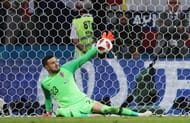
Croatia have one of the most underrated defences in the world. Led by AS Monaco keeper and 2017 Ligue 1 Goalkeeper of the Year Danijel Subasic, they are tactically flexible and very experienced - everyone who has played in their back four so far has been over the age of 29.
While an ageing defence usually means flagging, slow players, with volatile performances, Croatia's defence is the opposite, with full-backs Sime Vrsaljko and Ivan Strinic bombing up and down the pitch to contribute to the attack using the width of the pitch, while also falling back when needed. Center-backs Domagoj Vida and Dejan Lovren are slow, but have the technical skills are well as the physicality to compensate for this.
Throughout the tournament, Zlatko Dalic has gone with the back four mentioned in the previous paragraph but has changed his tactics in each game to adapt to the conditions of the game. For example, in their game against Argentina, the full-backs marked the Argentinian wingers (Acuna and Salvio) at all times, while the two centre-backs held tight near the box while Marcelo Brozovic marked Lionel Messi.
Another example is in the Round of 16 clash against Denmark, where the full-backs stayed put while making quick runs into the midfield, while the wingers tried to make space to play in the 4-3-3 formation instead of the 4-5-1 formation.
However, not all of these tactics work, as shown in their recent game against Russia, where the centre-backs were not quick enough to handle the agility of Aleksandr Samedov and Denis Cheryshev, and collapsed on occasion. Despite this, they won thanks to Danijel Subasic's impressive performance behind the sticks, and are now through to the semi-finals.
#4 Strength in the flanks
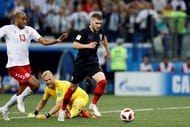
Back in 2014, Croatia had a big problem in the flanks which is said to have been the reason for their elimination from the Brazil World Cup. They lacked any natural wingers and had to rely on Luka Modric and Ivan Rakitic, to create their chances from the midfield, which proved to be a durable tactic in the long-term, after their disappointing performance in the aforementioned World Cup.
However, Croatia have more than fixed this problem after Zlatko Dalic started to deploy Inter Milan regular Ivan Perisic and Ante Rebic, the youngster who was essential in Eintracht Frankfurt's first piece of silverware in 30 years, on the flanks. They have been a great partnership on the wings, and have consistently been an integral part of manager Zlatko Dalic's plans.
Unlike in the past, the Croatian wingers created chances regularly, through counter-attacks and quickly advancing play with the attacking midfielders, while pressing the opponents' defenders constantly. As both Perisic and Rebic are agile and very skilful, they can also run into space when needed, as seen in Croatia's group match against Argentina, where the wingers were the reason Argentina were not able to play freely, with the Argentinian side-backs having to stay back to defend.
In addition to their skills as wingers, both Perisic and Rebic are very versatile and can play in other positions. When playing for the national team, Perisic starts on the left wing, while Rebic starts on the right wing, but their versatility enables them to swap their positions whenever necessary, as seen many times in the Croatia - Nigeria game. This confuses the opposition, which works heavily to Croatia's favour.
Even if either Ivan Perisic or Ante Rebic falls out of form or gets injured, Croatia have a reliable alternative in Schalke youngster Marko Pjaca. Pjaca is tall at 186 cm, and can take on opponents in 1v1 situations with ease thanks to his speed and dribbling skills. Just like his fellow Croatian wingers, he is also versatile and can play on either wing comfortably, which makes him a perfect alternative in the flanks for Croatia.
#3 An experienced squad
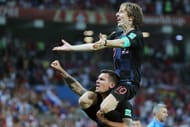
Croatia has an experienced squad in comparison to other teams, with an average squad age of 28, and average caps at 40. Comparatively, their semi-final opponents England have an average squad age of 26, and average caps at 20 appearances.
This experience is sure to help Croatia, as most, if not all members of the squad are proven to perform consistently at a high level, even under pressure, barring a few exceptions such as Marko Pjaca, who is still 22 and a developing talent, albeit for Italian champions Juventus.
The most prominent examples of this antecedent experience is in the midfield, which is primarily occupied by Luka Modric, Ivan Rakitic, and Marcelo Brozovic. Both Modric and Rakitic have been starters for arguably the two biggest clubs in the world, in Real Madrid and FC Barcelona, their respective clubs for four seasons now. Brozovic has been a regular for Italian giants Internazionale and has racked up over a hundred caps in his three years at the club.
From the aforementioned players, both Ivan Rakitic and Marcelo Brozovic are arguably at their peak, at the ripe age of 30 and 29 respectively, as shown by the consistency they both have shown in the tournament.
On the bench (for the midfield) are Real Madrid super-sub Mateo Kovacic, Fiorentina captain Milan Badelj, and Vedran Corluka, who has over 100 caps for Croatia. Even in attack and defence, Croatia has plenty of experience, with the likes of Juventus mainstay Mario Mandzukic and Inter Milan ace Ivan Perisic, and the long-standing partnership between Domagoj Vida and Dejan Lovren in the heart of defence. In between the sticks for Croatia is Danijel Subasic, who has played for Croatia since 2009, and has over 50 caps in his international career.
This shows the amount of sheer experience Croatia has, which could easily be used to outsmart the other, more youthful teams in the semi-finals.
#2 Zlatko Dalic's meticulous game plans
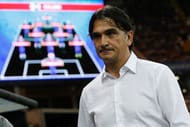
Zlatko Dalic has not been managing Croatia for a long time - for 8 months, in fact, after Ante Cacic was sacked when Croatia's progression into the tournament was threatened after poor tactical decisions led to several defeats against the likes of Iceland and Turkey.
Despite being appointed at such a onerous time, Zlatko Dalic was able to lead Croatia into the World Cup, after they beat Greece in a dominant fashion. This can be attributed to the fact that the former Croatian defensive midfielder meticulously plans tactics and strategies for every game.
Unlike previous managers, he doesn't play Croatia in a strict 4-2-3-1 formation, but rather loosely maintains the 4-1-2-2-1 formation with wingers, and bases the team on its central midfield, rather than its striker, who would have to make chances on his own.
Dalic deploys wingers on the side to exploit space and cross the ball in for the striker, while the central-midfielders try to create space in the middle, while passing to the wingers to try and stretch the defense. This strategy has proven to work time and time again, as Croatia's attack has been lethal in the World Cup (and the friendlies preceding it), with each player having their own role in the team; Luka Modric plays a creative role to make chances, Ivan Rakitic tries to advance play from the defense to attack while pressing the opponents' central-midfielders, the wingers exploit space and cross to the striker, and Mario Mandzukic tries to create space to shoot.
One unique thing about Zlatko Dalic is that he changes his tactics accordingly to his opponents, by changing the way Croatia play, while maintaining the basic roles each player has. Depending on the opponents, he can change how high the line of defence is, how aggressive the pressing on the opponents should be, and how tight the midfield should be (to mention a few variables), as shown in Croatia's games against Nigeria and Greece.
In the game against Nigeria, the midfield was tight with the wingers falling back, while the defence stayed put near the box. On the other hand, against Greece, he let the wingers roam free, and the midfield advance forward, while the defence pressed Greece's wingers assertively.
In both cases, the tactics were slightly different, but the results were the same, with Croatia exploiting the opponents' weakness and coming out on top.
#1 Dominance in midfield
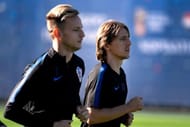
The heart of a team is undeniably the midfield, as it is the gateway between the defence and attack, and few teams are as dominant in midfield, as Croatia.
Croatia's midfield consists of Luka Modric, who consistently performs well for both Real Madrid and the national team, and is undeniably one of the best midfielders in the world right now, Ivan Rakitic, who is an extremely versatile workhorse in La Liga champions FC Barcelona's midfield, and one of: Fiorentina captain Milan Badelj, or Marcelo Brozovic, who has had a highly successful season in Serie A with Inter Milan.
In the present World Cup, Croatia has been using the 4-3-3 formation, with a standard midfield that has two central-midfielders, and one defensive midfielder. Luka Modric and Ivan Rakitic are two mainstays in the central midfield position, with the Croatian captain playing a creative role to try and create chances for the front three, while Ivan Rakitic tries to advance play from defence to midfield by making quick passes in the middle while defending and attacking when needed.
In the defensive midfielder role is one of Milan Badelj or Marcelo Brozovic, and depending on who is playing, they have different roles. Milan Badelj is a very defensive-minded midfielder, and he stays back while the attack is progressing to prevent the counter-attack, while Marcelo Brozovic plays the passing game and advances forward with the other midfielders, playing a more box-to-box position.
Even if one or more of these midfielders falls out of form, Croatia has two highly talented midfielders who could slot into the midfield easily, in Mateo Kovacic and Filip Bradaric. Kovacic can play the role of one of the two central-midfielders, while the highly versatile Bradaric can play in the position of just about anyone in the midfield.
